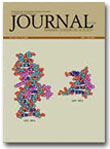فهرست مطالب

Journal of the Iranian Chemical Society
Volume:2 Issue: 2, June 2005
- تاریخ انتشار: 1384/03/15
- تعداد عناوین: 10
-
Page 78In this review we report the application of molecular modeling based on different analytical methods to locate the binding sites of anti-AIDS drug azidothymidine (AZT) in the major and minor grooves of DNA and RNA duplexes. The effects of drug complexation on nucleic acids secondary structures and the biological implication are discussed.
-
Page 85In this review article, some recent advances of applying heteropoly acids and polyoxometalates as heterogeneous, reusable and eco-friendly catalysts in organic synthesis are discussed.
-
Page 115Several new pyrazolo [3,4-d] pyrimidine, pyrazolo [3,4-e][1,4] diazepine, pyrazolo [3,4-d][1,2,3] triazine and pyrolo [4,3-e][1,2,4] triazolo [1,5-c] pyrimidine derivatives were prepared by the reaction of the corresponding 5-amino-pyrazole-4-carbonitrile derivative with different organic reagents under different reaction conditions. Using IR, 1H NMR, and mass spectra we have characterized all new compounds.
-
Page 1244-Sulfonamide substituted benzamidobenzimidazolones were designed and docked into the active site model of CDK2, using an oxindole inhibitor as the template. Compounds 6a-6i were then prepared from the reaction of the sulfonyl chloride 1 with different amines to give the corresponding acids (2a-2i), which were converted to their corresponding acyl chlorides (3a-3i). Reaction of 3a-3i with o-nitrophenylhydrazine afforded the respective nitro derivatives (4a-4i). The nitro groups were then reduced to give the corresponding amines (5a-5i), which, upon reaction with ethyl chloroformate, the target compounds (6a-6i) were produced. Target benzimidazolone derivatives (9a-9e) were also prepared from the reaction of isopropenyl benzimidazolone (8) with different sulfonyl or acyl chlorides. The target compounds were then tested by a modified 3-(4,5-dimethylthiazol-2-yl)-2,5-diphenyltetrazolium bromide (MTT) assay against the cancer cell lines, Hep G2, HT-29, CL1-5 and AGS. Despite similar binding properties of the flexible benzamidobenzimidazolones and rigid cytotoxic oxindole inhibitors at the active site of CDK2, biological screening results indicated that benzamidobenzimidazolones did not exhibit significant cell growth inhibition in vitro. Their analogue, 3-acyl benzimidazolone (12), however, revealed cytotoxicity similar to that of the reference oxindole inhibitor.
-
Page 135The non-rigid molecule group (NRG) theory in which the dynamic symmetry operations are defined as physical operations is a new field in chemistry. Smeyers, in a series of papers, applied this notion to determine the character table of restricted NRG of some molecules. For example, Smeyers and Villa computed the r-NRG of the triple equivalent methyl rotation in pyramidal trimethylamine with inversion and proved that the r-NRG of this molecule is a group of order 648, containing two subgroups of order 324 without inversion [5].In this work,a simple method is described, through which it is possible to calculate character tables for the symmetry group of molecules. We study the full NRG of melamine, and prove that it is a groups of order 48, with 27 and 10 conjugacy classes. Also, we compute the symmetry of melamine and prove that it is a non-abelian groups of order 6. The method can be generalized to apply to other non-rigid molecules.
-
Page 1404-(2,5-Dioxo-2,5-dihydro-1H-pyrrol-1-yl)benzoic acid and its complexes with methyl-, n-butyl-, phenyl-, benzyl- and octyl-tin have been synthesized and characterized by elemental analysis and spectral studies. The geometry around the tin atom has been deduced from both solid and solution studies. These complexes were also tested against different bacteria and fungi to determine their toxicity. LD50 data was also calculated using the Brine Shrimp method.
-
Page 149A supported-catalyst system for the polymerization of styrene was prepared by the immobilization of pre-activated indenyl titanium trichloride (IndTiCl3) with methylaluminoxane (MAO) on silica. This catalyst showed a higher productivity using a smaller amount of metallocene on the catalyst support. Other polymerization conditions that affect the productivity of the catalyst, including the ratio of Ti/SiO2 (wt%) and Al/Ti, and the time for polymerization, were also investigated. The polymers obtained from this system were extracted using methylethyl ketone and the syndiotacticity was calculated from the weight of the remaining insoluble polymer. With these optimized conditions, and the use of a heterogeneous catalyst, we developed a more efficient catalyst system that is more suitable for industrial applications than previously developed systems.
-
Page 155A highly regioselective ring opening of epoxides with aromatic amines in the presence of a catalytic amount of Zn(OAc)2 and a recently synthesized podand under solvent-free conditions is described. The yields of the amino alcohols are uniformly good and the recovered catalyst could be used in new attempts without any purification.
-
Page 161A simple, rapid and accurate spectrophotometric method is described for the determination of trace amounts of vanadium using variamine blue (VB) as a chromogenic reagent. The method is based on the oxidation of variamine blue to form a violet-colored species on reaction with vanadium(V), having an absorption maximum at 570 nm. Beer’s law is obeyed in the range of 0.1-2.0 µg ml-1. The molar absorptivity and Sandell’s sensitivity were found to be 1.65 Χ 104 l mol-1 cm-1 and 0.003 µg cm-2, respectively. Optimum reaction conditions were evaluated in order to delimit the linear range. The effect of interfering ions on the determination is described. The proposed method has been successfully applied to the determination of vanadium in steel, pharmaceutical, environmental, and biological samples.
-
Page 168In the present work, the authors describe the synthesis of some mixed ligand complexes of thorium(IV) derived from 4[N-(2''-hydroxy-1''-naphthalidene)amino]antipyrine semicarbazone (HNAAPS) or 4[N-(cinnamalidene)amino]antipyrinesemicarbazone (CAAPS) as primary ligand and diphenyl sulfoxide (DPSO) as secondary ligand with the general composition ThX4.n(L).DPSO (n = 1, X = Cl, Br, NCS or NO3; n = 2, X = I or ClO4, L = HNAAPS or CAAPS). All the compounds were characterized through elemental analysis, molar conductance, molecular weight, infrared data and thermogravimetric analysis. The infrared studies reveal that the semicarbazones behave as neutral tridentate (N,N,O) while DPSO coordinates through its oxygen atom. The nitrates are bicovalently bonded, while thiocyanates are N-coordinated in these compounds. In conclusion, the coordination number of the central metal ion displays coordination number 7, 8, 9 or 12 depending on the nature of the anionic ligands.

